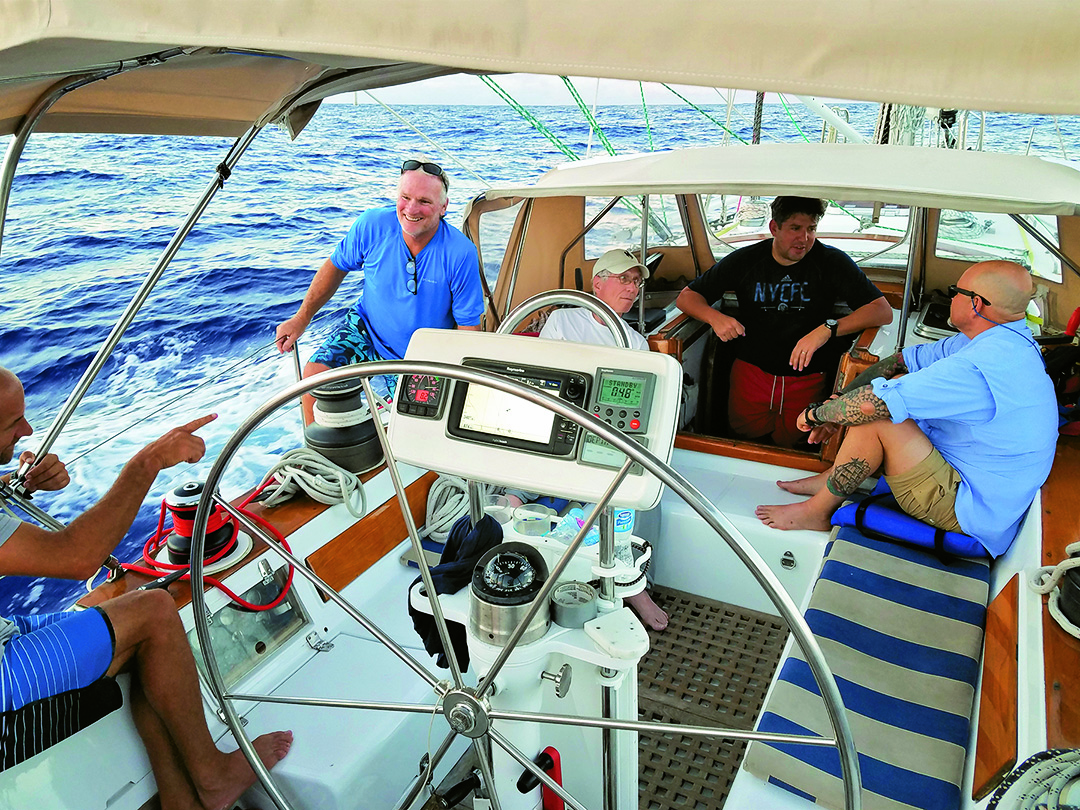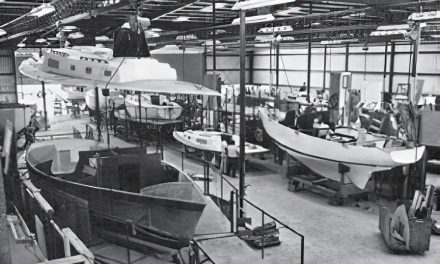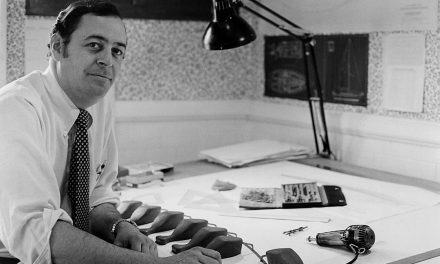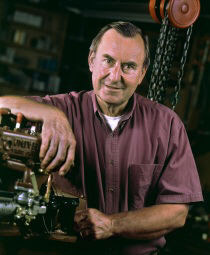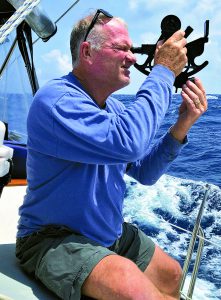
John takes a sun sight aboard Quetzal. Courtesy John Kretschmer.
In a lifetime of passagemaking and writing, John Kretschmer pays the love of sailing forward.
When we were planning our eventual leap to the full-time sailing life, my boss brought a book into work for me one day. It was old and tattered, and on its cover was a 20-something guy looking resolutely salty in yellow foul- weather gear, the sea swelling behind him. My boss said it was a great read and I should check it out before we set sail. But I never did, and once we moved aboard the book was packed on a shelf in our Moody 47, Roam, and there it stayed.
Two years later, in St. Martin preparing for our first Atlantic crossing, a friend mentioned there was someone in the anchorage I should interview. His name was John Kretschmer. While it sounded familiar, I still didn’t put two and two together. But I had a lovely time talking with John, his wife, Tadji, and two young crew members. We sat around the saloon table of his Kaufman 47, Quetzal, and the conversation flowed freely like we were old friends.
Back on Roam, I told my husband, Dave, some of John’s stories, and something made him go the bookshelf. Lo and behold, it was John on that cover, and the book was Cape Horn to Starboard, what would be the first book in a remark- able maritime career. Now 60, with more than 300,000 sea miles under his keel—many of them with the hundreds of people who have learned offshore sailing skills aboard Quetzal—and six books since that first coming-of-age story, John Kretschmer has carved a unique path guided by two polestar passions, sailing and writing.
It sure didn’t start auspiciously.
Born and raised in Detroit, a long way from blue water, he fell in love with the sea in books. “I told my middle school counselor that I wanted to sail all around the world and write books about it, and she laughed at me,” he says.
He’d dropped out of college four times by the time his mother sat him down. “I know you’re not as stupid as you seem,” she told him. Then she made John an offer he couldn’t refuse. She told him she would match his savings, dollar for dollar, so long as he used the money to buy a boat and sail away.
“I was 19 at the time,” recalls John, “so I bought a little 27-foot Bristol, moved aboard, and never stopped.” Until that time, sailing was all that John ever thought about, and his mother’s nudge was what he needed to take the leap and follow his dreams. At 24 years old, he and a partner sailed a Contessa 32 from New York to San Francisco around Cape Horn the “wrong” way, upwind, becoming the smallest boat to manage the feat.
“It was a crazy hard trip, 162 days in three legs,but I did get a bit of notoriety afterwards and wrote my first book,” John says. “I then more or less stumbled into the delivery business and became one of the busiest skippers around. One year I did three transatlantics and a passage from Fort Lauderdale to Japan.”
Despite most sailors’ perfectly reasonable aversion to the North Atlantic in winter, John took his chances and delivered a yacht from Rhode Island to Stockholm one January. He endured back-to-back gales for weeks on end and seas so huge he was terrified. “I think of all the crazy trips I’ve done, that delivery in the middle of winter was probably the worst,” he says. “But in its own way, kind of beautiful too.”

John and crew work on plotting techniques while underway. Courtesy John Kretschmer.
His endless fascination and love affair with the sea grew even more nuanced after he began John Kretschmer Sailing, his business training people how to make offshore passages. (He made the move, he says, after having two daughters and needing to be a bit more scheduled. His daughters, who love sailing, come aboard Quetzal every year for a week or so, as does one of Tadji’s two sons.)
It’s a simple concept, really: Give people who want to hone some offshore chops, face some scary weather, see whether the reality of days and nights at sea meets the romance, a chance to experience all of it with a proven expert as their guide. Though the passages
take place all over the world, the fundamental idea is the same, learning everything, from celestial navigation to watch standing, by doing.
“The reason why we have been able to log more than 150,000 miles of training passages, through several Force 9 and 10 storms with crews of widely varying experience, is because I empower the crew,” John says. “They participate fully, we have shared adventures and shared responsibilities. I am serious about this, and it’s been a great discovery. Everyone who signs aboard is a successful person and for the most part has a habit of making good decisions. Those traits and instincts don’t go away because you’re on a boat far from land. My job as a skipper and as a teacher is to find what people do best, how they can contribute, and tap into it. I really don’t have time for rule-driven experts laying out narrow parameters for how everything must be done.”
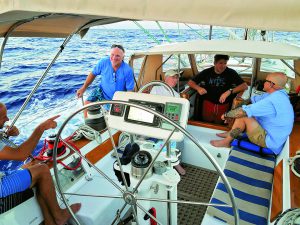
Sailing offshore and learning together creates strong bonds between John and his crews. Courtesy John Kretschmer.
Not surprisingly, the crucible that is a relatively small boat offshore, subjected to the heat that can be life at sea, creates strong bonds, and John says that he has friends all over the world as a result of his business. And before they slip the lines, they understand that they are responsible for themselves, and by extension each other.
“We’ve had things go bad, two knockdowns, serious gear failure, but almost to a person, people have risen to the occasion,” he says. “Not to be melodramatic, but there’s a lot of honesty in a gale, there’s no room for bullshit. As a skipper you have to let everyone know that we’re in this together, counting on each other. Sure, people feel safe with me because I’ve been there before, but every gale, every storm is personal. I lay this story line out to everyone during the safety briefing on day one.”
By its nature it’s an adventure, and stuff happens. There was the training passage from the States to the Caribbean when Quetzal was sailing through a Gulf Stream storm and was picked up by a 30-foot wave. As they surfed down, the wave broke over them. “It ripped the bimini and dodger clean off, and everything in the cockpit was just eviscerated. It was one of those moments where time really slowed down, I can remember my thoughts so vividly. We were in the curl of the wave, and the next minute we weren’t exactly sure if we were still on top of the water or under it, because there was so much water over the boat. I re- member thinking that we were either going to pitchpole or skid sideways, broach, and roll, and I knew if either of those things happened, we’d be toast. I’d been dodging this wave my whole life, and I remember thinking that, should my time be up, I’d had a pretty good run,” he says.
They didn’t roll or pitch-pole, but the moment wasn’t over. The boat hit the bottom of the wave and they reverberated off the wall of water surrounding them.
“There was a massive hissing sound all around us, and we were in the slick of the wave. I remember looking at one of my crewmembers and she gave me a thumbs up, and for a few seconds we just looked at one another in shock. The next thing we knew, another wave came and swept her right off the boat, the back of her knees catching the stern rails of the pulpit. I leapt over and grabbed her by her thighs, but I couldn’t get the leverage to pull her back in. She had a death grip on the lifelines, and I was pulling and screaming at her to get her ass back on the boat.”
Finally managing to pull her back on board (and she was tethered), the crew limped to shore, aware of how close they had come to disaster. That same woman went on to buy her own boat and cruise the Caribbean for six years.
Then there was the coup in Yemen. “That was kind of terrifying. We were there as a civil war broke out and we inadvertently sailed right into it. It was just luck that we were the last boat to enter that harbor and the only one to escape.”
Given the close shaves, what keeps him coming back for more?
“I just feel an incredible sense of relief when I get out on the water, the stress fades away from me as the land recedes. I think that’s why I’ve been able to do this my whole life. Once I’m underway I feel like I have purpose, and all the nagging things that were bugging me just fade away,” he says.
And, he says, he learns on every passage.
“I have changed a lot over the years. I have realized that you need to listen as a skipper, not just talk. You need to listen to your boat, she’ll tell you what’s wrong; you need to listen to the crew, they have valuable insights. You need to listen to the ocean, especially at night when your eyes can deceive you.
“I guess I am trying to say that after all these years I am really at home at sea, and my desire is for people to realize that a passage is not just an interlude between landfalls. It’s magical in its own right, and if you can be as comfortable and happy at sea as you are on land, well then the world shrinks for you because you can sail anywhere.”
Sailing, though, is only one part of the alchemy that is John’s career. All along, since he was a boy, there have been the words. After Cape Horn to Starboard, he worked hard at the craft, eventually becoming a contributing editor at Sailing magazine. He also wrote a column in the Miami Herald on sailing and traveling, and his story on Gregoria Fuentes, Ernest Hemingway’s last captain, for the Los Angeles Times magazine was nominated for a National Magazine Award. All the while, he managed to squeeze out the time and head space to write books.
“My second book, Flirting with Mermaids, published in 1999, was a game changer,” he says. “It was chosen, along with Sterling Hayden’s Wanderer and Bernard Moitessier’s The Long Way, as one of three Mariner’s Classics by Lyons Press. This blew me away, to be lumped in with two of my idols.”
His book At the Mercy of the Sea was chosen as one of the top 25 nonfiction books of 2007 by the Southern Independent Booksellers Alliance. His most recent book, Sailing to the Edge of Time, is about to be released in paperback, and all of his books remain in print.
“It’s hard to make a living just writing, and even in my hard-core freelance days, I always combined sailing with writing,” he says.
It goes without saying, then, that his middle school teacher missed the boat, and his mom was prescient. In fact, John became the inspiration for his mother to learn to sail. Years later, the very woman who had never sailed and who had no intention of learning circumnavigated with her partner in their Jeanneau 37.

Erin and John enjoying hanging out on Quetzal in Marigot Bay, St. Martin.
After spending several “captain’s hours”—John’s term for sundowners—with him in the anchorage in St. Martin, I came to realize that for John, the love of sailing and the sea is a gift to be passed forward. At one point, after I’d asked whether he thought Dave and I should carry a whisker pole on our Atlantic crossing, he picked up a carbon-fiber whisker pole—a spare he had, with the same connecting fitting that our boat needed— and said I could have it. I was flabbergasted, but he insisted, and he and the other crew members proceeded to put it into my dinghy right there and then.
As for that book my boss gave me, which sat on our shelf? John signed it, and I’m sending it back to my boss. He was right. It’s a great read.
This article first appeared in our January/February 2020 issue. Subscribe now for more great features like this one.

